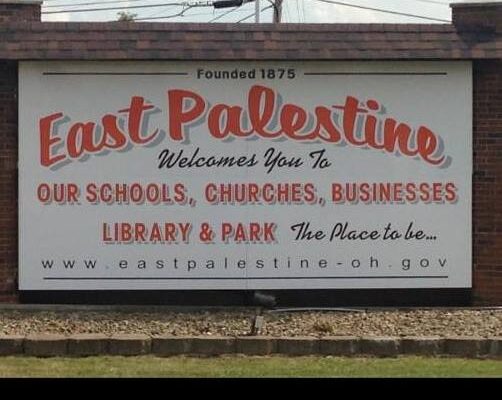Elsewhere in Ohio, there are towns named Hebron, Gilboa, Canaan and Shiloh. There’s even a Sodom.
By Rafael Medoff, Jewish Journal
A toxic spill has drawn the nation’s attention to the little town of East Palestine, Ohio, just as another tragedy, the explosion of the space shuttle Columbia in 2003, turned the nation’s gaze upon the town of Palestine, Texas, where much of the debris landed.
The tragic spotlight now shining on East Palestine naturally leaves some people curious as to why it has such as unusual name. The answer is that it’s not a very unusual name at all.
Elsewhere in Ohio, there are towns named Hebron, Gilboa, Canaan and Shiloh (two of them, in fact). There’s even a Sodom, which was given its name after a prohibition advocate, disappointed at the small turnout for his lecture in 1840, jokingly compared the locale to that infamous biblical center of sin.
In Texas, in addition to Palestine, there are towns named Hebbronville and Joshua. There is a Hebron in North Dakota and a Sinai in South Dakota, a Jerusalem in Arkansas, a Jericho in Vermont, a Bethlehem as well as a Nazareth in Pennsylvania and a Zion in Maryland. Nearly every state has one or more towns named after biblical sites or individuals. Altogether, there are more than 1,000 biblically-named towns from coast to coast.
Towns such as East Palestine, Ohio were established by 19th-century religious Christian settlers. They chose those names to express their spiritual attachment to the land and people of the Bible. When they thought of Palestine, they recalled the Jewish kingdoms and temples of ancient times, as well as the events surrounding the origins of Christianity in the Jewish town of Bethlehem. In their prayers, they prayed for the return of the Jews to the Holy Land, which they understood to be inextricably linked to the coming messianic age.
The area that became East Palestine was originally known as Mechanicsburg. There are a number of towns in the U.S. that were originally settled by mechanics of various types. But in the case of Ohio, “Mechanicsburg” was changed in 1836 because—according to an early history of the region—“the wife of Dr. Robert Chamberlin desired a more euphonious appellation and desired it [be] called ‘Palestine,’ the quiet beauty of the little town, and the earnest, virtuous, simple life of its people suggesting to her a name recalling holy memories.”
Since there already was a town named “Palestine” in the western part of the state—likewise founded by religious Christians who wanted to infuse their town with “holy memories”—government officials, in assigning the new post office, added the prefix “East.”
That early account of East Palestine’s founding was published in 1905, when it was common for a married woman’s name to be hidden behind that of her husband. But a historical marker in front of the log house where the Chamberlins once lived tells us that the name of the doctor’s wife was Rebecca—an appropriately biblical name for a woman who took her Bible seriously.
Not surprisingly, numerous churches quickly sprung up in East Palestine and its environs. Lutheran and Reformed congregations established the Salem Church, choosing a name derived from “Jerusalem.” Evangelical Lutherans founded the St. Paul’s Evangelical Lutheran Church, while Methodists originally held their services in a local school—the separation between church and state was still rather fuzzy in those days—before eventually erecting their Methodist Episcopal Church. East Palestine also had a United Presbyterian Church and, later, another house of worship with a biblically-inspired name, the Zion Evangelical Lutheran Church.
When America’s religious Christian settlers thought of the Holy Land, they thought of the Hebrew Bible and the area’s 3,000 years of Jewish habitation, not the Koran or the more recently arrived Arab residents of the area. They thought of the many Jews who appear in the accounts of the birth of Christianity (including its founder), texts that do not mention any Palestinian Arabs.
Certainly Americans were aware that there were Arabs living in Palestine in the 19th century. Mark Twain, for example, had mentioned them in his account of his visit to the Holy Land, The Innocents Abroad (1869). So had Herman Melville in his famous “Clarel: A Poem” and Pilgrimage in the Holy Land (1876).
But it was common knowledge that the Arab population of Palestine was relatively small and unsettled, and that the Arab residents of 19th-century Palestine regarded themselves as part of southern Syria, not as a separate nationality. H. Allen Tupper, Jr. wrote in The New York Times in 1896, after having “ridden on horseback more than four hundred miles through Palestine and Syria,” that virtually the only local people he encountered were “merchantmen with their long camel trains” and “wild Bedouin tribes” that “reside in one locality not more than two months.”
Today’s residents pronounce East Palestine “Palesteen,” but the original settlers undoubtedly pronounced it the more common way. Because it was the Holy Land, with its deep Jewish roots, that burned bright in the hearts and prayers of the founders of the many biblically-named towns across America. And it is for the same reason that Bible-believing Christians today—probably including more than a few residents of East Palestine, Ohio—constitute one of the major sources of pro-Israel sentiment in the United States.
Dr. Rafael Medoff is the author of more than 20 books about Jewish history and Zionism, including The Historical Dictionary of Zionism, written with Chaim I. Waxman.




